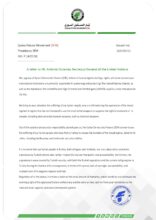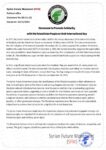Syria after the assassination of the Presidents!

Three helicopters arrived, only two landed, and the third, coincidentally, was the aircraft carrying the President of Iran (Ibrahim Raisi) and his Foreign Minister (Hossein Amir Abdollahian), the Governor of East Azerbaijan (Malik Rahmati), and a religious Imam from Tabriz Province (Mohammad Ali Hashem)!
It would be useful in a state ruled by clerics to attribute it to fate and destiny, as the Twelver Shia believe that both good and evil fates come from God. The School of Ahl al-Bayt has taken a middle path between the Ash’ari and Mu’tazila schools, adopting the doctrine of ‘Amr Bayn al-Amrayn’ (a matter between two matters) where they did not side with predestination nor with delegation of power. This third theory, comprehensive and preserving what both sides uphold, has not yielded results in the fields of predestination and delegation. The result of this theory is that divine decree and destiny do not render a person helpless in their actions, desires, and determining their fate. On the other hand, the issue of choice in human affairs does not diminish the sphere of divine majesty and sovereignty; both divine knowledge of actions and human choice harmonize in this theory(1).
Therefore, it would be convincing for the official discourse to be faith-based without blaming anyone, even though the event in reality was a first-degree assassination, as shown in Khamenei’s statement where he says: ‘This bitter incident occurred while making efforts to serve, and every moment of this man’s noble and sacrificial responsibility, whether the short duration of his presidency or before that, was spent in continuous efforts to serve the people, the country, and Islam’ (2).
Messages of the operation:
Three messages in Raisi’s assassination according to leaked information:
The first message: The American magazine Foreign Policy previously described Raisi’s and Abdollahian’s policies as ‘hawk diplomacy,’ considering them a direct threat to the United States, given their economic and diplomatic expansion in various directions, and their strong diplomatic path towards the East, strengthening relations with Moscow and Beijing, in a time when they also held a reconciliatory stance with Saudi Arabia and the UAE under Russian sponsorship, as well as supporting non-state actors within what is called the Resistance Axis, which includes (Lebanese Hezbollah, the Islamic Resistance Movement Hamas in Palestine, and the Houthi group in Yemen)(3).
Raisi is considered the primary and acceptable candidate by the Iranian Revolutionary Guard and by the Supreme Leader Khamenei. An article published in the Foreign Affairs magazine in the May/June 2017 issue by writers “Sanam Vakil” and “Hussein Rassam” titled ‘The Next Supreme Leader of Iran… The Islamic Republic in the aftermath of Khamenei’, discussed the ‘deep state’ established by Khamenei, its relationship with the Revolutionary Guard, and the prominent candidates for his succession, concluding that Raisi’s chances are strong. In March 2016, ‘Ibrahim Raisi’ was appointed as the head of the Holy Shrine of Imam Reza, a massive charity organization controlled by the Office of the Supreme Leader, the same year that marked Raisi’s rise as the most prominent successor to Khamenei.
Also, Raisi progressed in judicial positions; after heading the team that prosecutes corruption in state-owned entities, he was appointed in 2004 as the Deputy Chief of the Judiciary, elected to the Assembly of Experts in 2006, and held the position of Secretary of the Committee overseeing the Supreme Leader within the Assembly. In 2014, ‘Larijani’ appointed ‘Raisi’ to the position of the country’s chief prosecutor.
‘Raisi’ is known for his conservative and hardline policies; in 1988, as a prosecutor, he managed the mass executions of political prisoners, including members of the ‘Mujahedin-e Khalq’ organization, which demands the overthrow of the Iranian Republic.
The writers considered ‘Raisi’ the most likely candidate to succeed ‘Khamenei’; comparing him with other candidates, they found that ‘Raisi’ has the closest relationship with the deep state and the Revolutionary Guard, and throughout his professional life, he has maintained his absolute loyalty to both ‘Khomeini’ and ‘Khamenei’, alongside his conservative policy, judicial experience, political shrewdness, making him the ideal choice to protect the interests of the deep state established by ‘Khamenei’. Raisi ran in the presidential elections against President Hassan Rouhani.
In conclusion, the writers believe that the hopes that reformists place on the possibility of Iran becoming a more moderate and centrist state in the post-Khamenei phase are a form of ‘irrationality’, for two reasons: firstly, the deep state established by
Khamenei with its security, intelligence, and economic complexities, composed of his loyalists and his conservative and hardline policies and his concept of the Iranian state and its internal and external policies, will not allow someone who would bring reforms or radical changes that could harm its interests.
Secondly, even if hypothetically someone with reformist tendencies assumed the position of the Supreme Leader after Khamenei, challenging the will of the deep state, they would not last long against it; it would undoubtedly become a stumbling block before any reform attempts, leading to their failure.
The writers also believed that the candidate who would enjoy the support of the deep state is likely to have religious, conservative inclinations similar to Khamenei, in both domestic and foreign policies, and good administrative experience and knowledge, and most importantly, respects and ensures the protection of the deep state interests(4).
Therefore, the assassination operation carries a strong message that all Iranian symbols, including the Supreme Leader, are under control! Through the destructive power of Israeli missiles and the target bank it possesses, this became evident through the scenes of destruction in the southern Lebanese villages and the number of casualties on both sides, where the number of Hezbollah’s casualties reached about 300, while the number of Israeli army casualties did not exceed 30. The imbalance in power dynamics is clearly visible through the tracking and targeting of Israeli drones for elite Hezbollah leaders across Lebanese and Syrian territories, and according to field sources for ‘Janoubia'(5), ‘50% of Hezbollah’s field leaders have been martyred since October 8th’, thus revealing the true nature of the conflict with Israel that seeks to eliminate effective personalities whether in Iran, Lebanon, or Syria.
The second message: The Biden administration is retreating from supporting Israeli escalation towards Iran, for the Trump administration to advance and reap Israeli votes under the table through this assassination operation, and it will not stop at this level, as hinted by Dr. Zaher Baadarani, President of the Syrian Future Movement, in his article titled: ‘The American Elections and the Future of the Syrian File'(6).
The third message: Israel’s disavowal through its media of the assassination operation despite no accusations against it, where an Israeli official said on Monday, ‘Israel had nothing to do with the death of the Iranian President Ibrahim Raisi, in a helicopter crash incident, which also resulted in the deaths of his companions’, added the official who requested anonymity ‘It wasn’t us’, and no official comment from the Israeli government has been issued yet(7).
And this appears as if ‘the suspect is about to say take me’, and according to our information, the assassination operation and disavowal are a clear response to Iran’s disavowal of the Al-Aqsa Flood operation on October 7th(8).
Assad’s role:
The Russian newspaper Nezavisimaya reported that Iran suspects the Syrian government’s readiness to strike a possible deal with the West, highlighting that this rapprochement is the reason for Damascus’s relatively ‘moderate’ stance regarding the conflict in the Gaza Strip(9).
After Bashar al-Assad’s meeting with the Saudi Crown Prince who asked him to change his strategy to obtain international support for his political future, and after Iran’s refusal to withdraw from Syria, Assad was before Assad to present the head of Ibrahim Raisi just as Hafez al-Assad did by handing over Ocalan in 1998, which crystallized that delivery by signing the Adana Agreement, a secret security agreement between Turkey and Syria in 1998, to start a new phase of gradual rapprochement, where the two countries later signed dozens of agreements in various fields(10), thus Assad kills two birds with one stone:
First: He would have presented what can be presented and responded to the Saudi request for normalization with Israel and the expulsion of Iran.
Second: Assad secures Israel’s sponsorship for him under the agreed terms of service.
Conclusion:
It can be said that Ibrahim Raisi was assassinated in a concentrated professional operation that could only be carried out by strong intelligence that leaves no trace behind.
And it can be said that Bashar al-Assad was able to find cards he can play with, especially since the incident is far from his country, giving him the ability to maneuver with the Iranians.
Finally, Bashar al-Assad succeeded in presenting himself as an ally to Israel and became a headache for Iran, which now feels that he is no longer its strong desired ally, but is forced to deal with him because his presence makes Iran’s presence legitimate in Syria, but it is likely that they will soon leave him to their bitter enemy (Israel), and this gives us an impression of the future of Syria, which will be a brick in its expected wall.
The readiness for this future poses a re-reading of the Syrian situation by the opposition itself, to search for threads that weave themselves into the new Syrian plot that will be launched by the next American administration, so will the opposition succeed in using this reality for its benefit
and its goals?
Elias Abdul-Massih
Political Office
Research and Studies Department
Studies
Syrian Future Movement (SFM)
References:
(1) Al-Subhani al-Tabrizi, Theology guided by the Quran, Sunnah, and Reason, Volume 2, p341.
(2) X \ Imam Khamenei on X: ‘This bitter incident occurred while making efforts to serve. Every moment of this man’s noble and sacrificial responsibility, whether the short duration of his presidency or what preceded it, was spent in continuous efforts to serve the people, the country, and Islam.’
(3) After the departure of the Iranian President and his Foreign Minister.. Does ‘hawk diplomacy’ end? (msn.com)
(4) Future Center – Who are the most likely candidates to succeed ‘Khamenei’? (futureuae.com)
(5) 300 martyrs for the party compared to 30 casualties for Israel.. What remains of the ‘deterrence system’? – Janoubia (janoubia.com)
(6) The American Elections and the Future of the Syrian File – Syrian Future Movement (sfuturem.org)
(7) Israel denies its involvement in Raisi’s death – 24 Site
(8) The death of Ibrahim Raisi and his companions.. Anticipated questioning in Washington (alaraby.co.uk)
(9) Russian newspaper: Does Iran really suspect Assad’s collusion with the West? | News | Al Jazeera Net (aljazeera.net)
(10) Turkish-Syrian relations: How Hafez al-Assad handed over Ocalan. – Baz News






